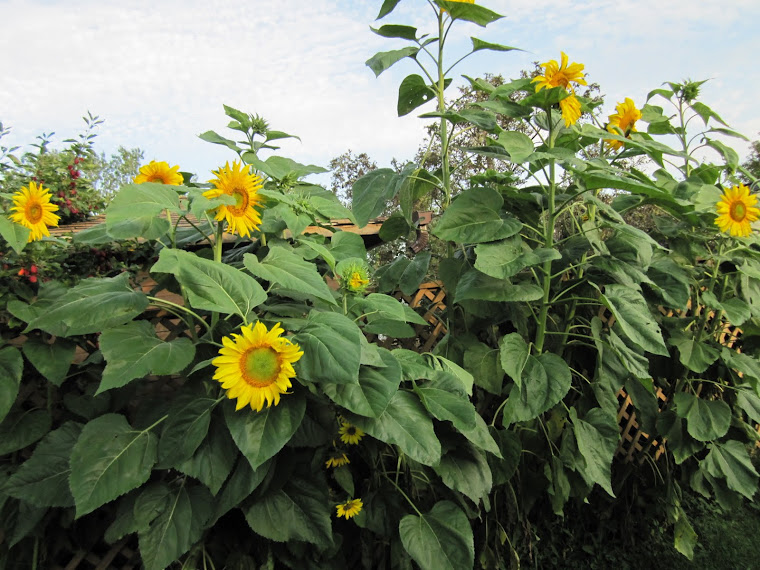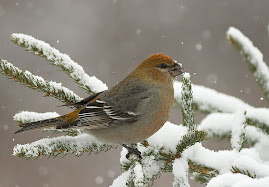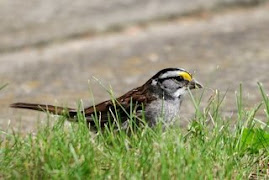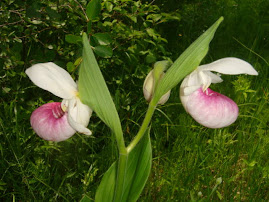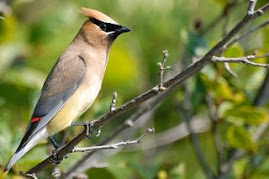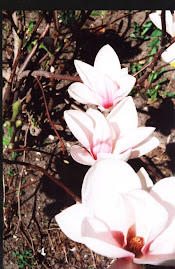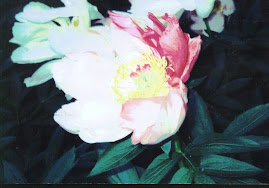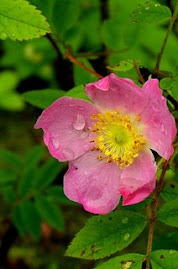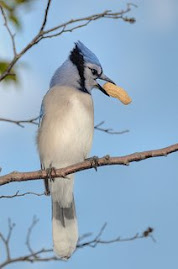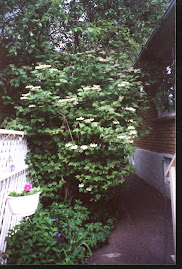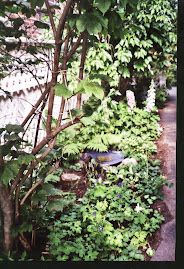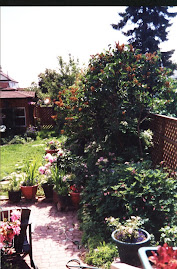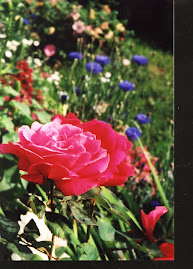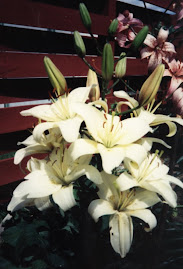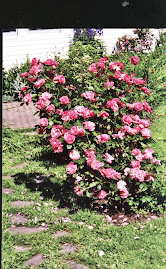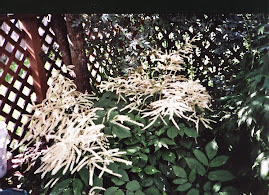The end of summer is here but the garden is perky - ready, aye ready to carry on into fall.
The phlox blooms on as do those stalwarts, the bachelor buttons, the impatience, the lobelia and the pinks. The cosmos are tossing out flowers from five foot high plants. The lavatera shines a silky pink.. The Asiatic lilies look seedy but the orienpets are magnificent, large and brassy. A cross between an Oriental and a trumpet lily, Orienpet lilies blossoms are huge and as ruffled as a ball gown.
The crab apple tree flaunts bright red fruit; the sea lavender, a late bloomer, presents a cloud of fluffy buds. It will be another week before the tiny flowers open.
The sweet peas dot the back lane fence with white and deep purple flowers. Sweet pea makes a long lasting bouquet, almost as good as the godetia, another great cutting annual.
The mountain ash and the high bush cranberry are sporting bright red berries but not for long. The birds will soon devour them. But the birds will not touch the crab apples until late in the winter when the fruit softens up and sweetens with the frost.
Meanwhile the longed for rain arrives flattening several plants. These will have to be staked up tomorrow.
On a trip south into Wisconsin, I saw fields of tansy, once a cultivated species but now growing wild. An old fashioned plant, it can be seen in a few gardens around town. Tansy is a tall plant with blazing yellow flowers and it will grow just about anywhere although it seems to prefer dry places. I even saw a patch growing along a bit of rocky shore of Lake Superior.
Further south, I ran into prairie flowers such as blazing star and the wonderful prairie sunflower. This small flowered plant also can be found in local gardens. At Crex Meadows, a wildlife sanctuary near Grantsburg Wisconsin, the wild sunflowers covered acres of prairie in brilliant gold. The grasses were marvelous there. I found some bluestem well over six feet high.
Friday, 29 August 2008
Monday, 25 August 2008
How Come?
A friend asks why her hosta is so small? Was it the rain early in the season or the heat in August? The fact is that the hosta is a dwarf variety, made small for edging walkways. Unfortunately my friend did not read the label. Her tiny hosta cost as much as the giants. Often hostas on sale are the tiny type so it pays to check the size,
I note here that my favourite hosta is the large variety sum and substance, not only for its pale chartreuse colour but also its resistance to slugs. I further note that the slugs are having a hard time in our perpetual rainless heat this August. Do I feel sorry for them? Nah!
Speaking of small things it is worthwhile to note that many plants come in various sizes. Last year I was asked why the nicotania in the garden was overshadowing the near by plants. Nicotania is another plant that comes in various sizes. There is also a small cosmos, confusing because it is orange or yellow in colour and not the expected pink and white of the tall type. To me it looks like an entirely different plant.
Speaking of rain, we need some. The weeds are cemented into the soil. Hot weather makes the last perennials turn pale and set seeds fast. You can run the hose but when the soil gets this dry, the water does not penetrate or spread far. If you scrape the damp surface you find the soil is dry a few centemeters down.
Tip. Check out The Key (delivered to all houses in Thunder Bay or available at the library). Page 111 tells you how to get a city tree for your boulevard or other public space. But, if you do take a free tree (or pay for one - both options are available) be prepared to protect your baby. Water and keep kids, bicycles and vehicles from damaging it.
I note here that my favourite hosta is the large variety sum and substance, not only for its pale chartreuse colour but also its resistance to slugs. I further note that the slugs are having a hard time in our perpetual rainless heat this August. Do I feel sorry for them? Nah!
Speaking of small things it is worthwhile to note that many plants come in various sizes. Last year I was asked why the nicotania in the garden was overshadowing the near by plants. Nicotania is another plant that comes in various sizes. There is also a small cosmos, confusing because it is orange or yellow in colour and not the expected pink and white of the tall type. To me it looks like an entirely different plant.
Speaking of rain, we need some. The weeds are cemented into the soil. Hot weather makes the last perennials turn pale and set seeds fast. You can run the hose but when the soil gets this dry, the water does not penetrate or spread far. If you scrape the damp surface you find the soil is dry a few centemeters down.
Tip. Check out The Key (delivered to all houses in Thunder Bay or available at the library). Page 111 tells you how to get a city tree for your boulevard or other public space. But, if you do take a free tree (or pay for one - both options are available) be prepared to protect your baby. Water and keep kids, bicycles and vehicles from damaging it.
Saturday, 16 August 2008
Buried in Marigolds
It is useful to keep copious garden notes. And even more useful to read them over from time to time. My notes from last May detail the planting of the patio pots and boxes. On May 19, I planted two large pots of acidanthera surrounded by lobelia crystal palace (the only lobelia which does not fry out in the heat) and pink dianthus. The two big cedar boxes received orienpet lilies with an edging of pansy, lobelia and dianthus.. The notes mention the cedar box of feverfew and a decorative pot of marigolds surrounding evening stock, not a successful pairing because the strong scent of the marigolds wipes out the sweet scent of the stock. I planted a long box of geraniums and various pots of herbs. Two small boxes of nasturtiums grace the top of the fence
But what is this? A big pot of white geraniums surrounded by tiny yellow mariglds? I had forgotten all about this arrangement. I go outside to check and see that the supposedly dwarf marigolds had grew ten inches high and filled the pot from rim to rim. . I push them aside and spot, cowering in the middle, three tiny geraniums barely alive. Quick action is needed. One pitiful plant has even set a bud trying to make a flower even though buried in marigolds.
Out they came and sit in individual pots on the back steps. By nightfall, they’d perked up. Not a moment too soon.
The cedar waxwings, birds that wander the continent, are in town. They’ve probably come for the mountain ash berries but in my garden they are eating the lilac seeds. Every once in a while they scarf down a bug even though they are not primarily insect eaters They always travel in flocks and keep in touch with each other by whistling a high call noe.
Tip. Hot and dry weather. Time for the soaker hose. Or use the regular hose to trickle water here and there. Less water is evaporated with this method and the water gets to the roots rather than settling on the leaves.
But what is this? A big pot of white geraniums surrounded by tiny yellow mariglds? I had forgotten all about this arrangement. I go outside to check and see that the supposedly dwarf marigolds had grew ten inches high and filled the pot from rim to rim. . I push them aside and spot, cowering in the middle, three tiny geraniums barely alive. Quick action is needed. One pitiful plant has even set a bud trying to make a flower even though buried in marigolds.
Out they came and sit in individual pots on the back steps. By nightfall, they’d perked up. Not a moment too soon.
The cedar waxwings, birds that wander the continent, are in town. They’ve probably come for the mountain ash berries but in my garden they are eating the lilac seeds. Every once in a while they scarf down a bug even though they are not primarily insect eaters They always travel in flocks and keep in touch with each other by whistling a high call noe.
Tip. Hot and dry weather. Time for the soaker hose. Or use the regular hose to trickle water here and there. Less water is evaporated with this method and the water gets to the roots rather than settling on the leaves.
Labels:
cedar waxwings,
garden record keeping,
soaker hose
Friday, 15 August 2008
August and the Annuals
This is the time of year when the annuals strut their stuff. The ample rains in the spring sent the cosmos growing. Some of the plants are over six feet. These, the most useful of annuals, produce soft green feathery leaves which fill in all the spaces now that the perennials have finished blooming. The other annual, planted in clumps in the perennial bed, is the pink lavatera, now unfolding in satin cups. The bachelor buttons (Jubilee Gem, a true blue) are blooming under the roses.
In spite of all this bounty, I was not able to find enough blooms to cut for the house. I like to run a continuous bouquet inside. I put the vase on the kitchen table where the flowers scent the room and are in full view. Roses, peonies, shasta daisies or lilacs married with the goat’s beard or baby breath make stunning displays but these plants have finished blooming for the season. Several perennials are not suited for cutting. The delphiniums and the monks hood do not last . Others, like the true geraniums, have floppy stems. Phlox releases hundreds of petals. Some of the smaller plants such as lily of the valley and the pansies make charming nosegay bouquets in a small vase but they too have come to the end of their time. Sweet William lasts well inside but mine are right by the patio and I don’t want to remove them.
So how to get a bouquet together. The sweet peas and the sea lavender, the best flowers for cutting, are still not ready. I planted no sunflowers this year. A vase of these look great as Van Gogh’s famous painting shows. So I pick a few of the emerging cosmos blooms here and there. Their stems look fragile but they are really quite wiry and so they stand up in the vase. I add a few bachelor buttons and monardas but the bouquet is skimpy indeed. So into the back lane I go to pick the ox eye daisies and this fattens up the group well enough to fill up a vase. I vase of daisies with a few colourful extras now sits on the kitchen table.
Tip. It’s not too late to plant day lilies and Asiatic lilies which are on sale this week
Tuesday, 12 August 2008
The Dew is Gleaming on the Grass
In the early morning the garden is very quiet. I hear only the honking sound of a nuthatch in the Manitoba Maples next door. The usual morning sing-a-thon has ended for this year. The birds have finished nesting and no longer sing to signify the boundaries of their feeding territories. (If only we humans could resolve our boundary disputes with a morning song!).
It may surprise some readers to learn that the migrating birds are now preparing to leave. Once the fledglings are out of the nest and independent, the time arrives to feed up and head south. Most of our migrating birds head down the Mississippi, and many carry on to South America. We now know that migrants move from one "island" of habitat to the next. In a world of urban sprawl, they are seeking brushy areas with water. I hope my garden provides what they need. Last spring, a few warblers, including a red start, stopped by for a rest and a drink. Many migrating birds are not looking for feeder food. Warblers, for instance, eat insects. The redstart worked the perennial garden for a day, eating bugs, and then it flew off. There were not enough insects in my small patch to entice it to nest.
Some of the migrants hang about to molt. This does not take long. An American goldfinch turns from hot yellow to delicate greenish yellow in ten days. The new feathers push the old feathers out. Gold finches are seed eaters who demolish the weed seeds in a garden.
With the abundant mosquito and fly population this summer, it has been a good year for birds, signifying reproductive success. The warblers come north for the bugs and we gave them a good feed up this summer.
I like to do my weeding in the early mornings. During the warm afternoons, the earth resists the trowel but in the dew-soaked earth, the weeds are easier to dig. The trowel attacks the dandelions and other deep rooted plants, but I also have another efficient weeding tool. I do not know its proper name but it is a simple thing, a loop of metal on a handle. It scrapes a layer of soil pulling out the plantain, the chickweed and other shallow rooted interlopers.
By eight o'clock the female ruby-throated humming bird swings by to hit up the delphiniums for nectar. It is possible that she nested in one of my trees but the nest is so small, the size of a thimble, that I'll never find it. She''s a migrant and feeding up for the voyage.
The bees fumble the monks hood. This is a stately blue and white plant, a short blooomer, which takes over the back of the perennial bed as the delphinium stalks slowly turn to seed. White monks hood grows in my front garden along with the true blue variety. This is one of the toughest customers and always survives the winter but it needs to be wired to a tall stake or it buckles at the knees.
A friend suggested I pull out the campanula, the robust blue bell flower that is growing in all the back lanes and here and there among my garden beds. I will do so once they set up their seeds but for now the bees love them dearly and I love and need the bees. Strangely the bell flower only grows flowers on one side of its stalk. This plant also spreads by creeping root, so Iwon't be able to eliminate it entirely. I'll just keep it in check.. I note here the bees also love the mullein. Another reason to accept native plants.
The same friend also wondered why I let the arabis creep through the garden around the perennials. Perhaps I should cut it back? But arabis is a tricky plant. It can be killed over the winter, especially if we have no snow. So for now, I let it spread and fatten, knowing that a lot of it may not survive by spring.
I can't believe I am still pulling meadow rue, dame's rocket and forget-me-nots, trying to yank them out before they spread too many seeds. For an unknown reason, the policeman's helmets (or Himalayan impatiens) did not seed into by garden this year. I miss it.
Tip. On hot days, get out early for easier weeding.
It may surprise some readers to learn that the migrating birds are now preparing to leave. Once the fledglings are out of the nest and independent, the time arrives to feed up and head south. Most of our migrating birds head down the Mississippi, and many carry on to South America. We now know that migrants move from one "island" of habitat to the next. In a world of urban sprawl, they are seeking brushy areas with water. I hope my garden provides what they need. Last spring, a few warblers, including a red start, stopped by for a rest and a drink. Many migrating birds are not looking for feeder food. Warblers, for instance, eat insects. The redstart worked the perennial garden for a day, eating bugs, and then it flew off. There were not enough insects in my small patch to entice it to nest.
Some of the migrants hang about to molt. This does not take long. An American goldfinch turns from hot yellow to delicate greenish yellow in ten days. The new feathers push the old feathers out. Gold finches are seed eaters who demolish the weed seeds in a garden.
With the abundant mosquito and fly population this summer, it has been a good year for birds, signifying reproductive success. The warblers come north for the bugs and we gave them a good feed up this summer.
I like to do my weeding in the early mornings. During the warm afternoons, the earth resists the trowel but in the dew-soaked earth, the weeds are easier to dig. The trowel attacks the dandelions and other deep rooted plants, but I also have another efficient weeding tool. I do not know its proper name but it is a simple thing, a loop of metal on a handle. It scrapes a layer of soil pulling out the plantain, the chickweed and other shallow rooted interlopers.
By eight o'clock the female ruby-throated humming bird swings by to hit up the delphiniums for nectar. It is possible that she nested in one of my trees but the nest is so small, the size of a thimble, that I'll never find it. She''s a migrant and feeding up for the voyage.
The bees fumble the monks hood. This is a stately blue and white plant, a short blooomer, which takes over the back of the perennial bed as the delphinium stalks slowly turn to seed. White monks hood grows in my front garden along with the true blue variety. This is one of the toughest customers and always survives the winter but it needs to be wired to a tall stake or it buckles at the knees.
A friend suggested I pull out the campanula, the robust blue bell flower that is growing in all the back lanes and here and there among my garden beds. I will do so once they set up their seeds but for now the bees love them dearly and I love and need the bees. Strangely the bell flower only grows flowers on one side of its stalk. This plant also spreads by creeping root, so Iwon't be able to eliminate it entirely. I'll just keep it in check.. I note here the bees also love the mullein. Another reason to accept native plants.
The same friend also wondered why I let the arabis creep through the garden around the perennials. Perhaps I should cut it back? But arabis is a tricky plant. It can be killed over the winter, especially if we have no snow. So for now, I let it spread and fatten, knowing that a lot of it may not survive by spring.
I can't believe I am still pulling meadow rue, dame's rocket and forget-me-nots, trying to yank them out before they spread too many seeds. For an unknown reason, the policeman's helmets (or Himalayan impatiens) did not seed into by garden this year. I miss it.
Tip. On hot days, get out early for easier weeding.
Labels:
arabis,
birds,
dame's rocket,
hummnng birds,
meadow rue.,
migrant birds
Saturday, 9 August 2008
August in Bloom
Sedum Autumn Joy. This tall sedum grows in the laneways and ditches around town but that is no reason to scorn it. In early August, it produces flower heads of an old fashioned purple-pink colour. A long bloomer, it is one of the last to die with the frost. In September, when all the garden is browning and few cut flowers are available, Autumn Joy makes a fine bouquet to bring inside along with other tall late-blooming flowers such as baby breath, late sweet peas and sea lavender.
Phlox. The abundant rain has given me abundant phlox. The white admiral has never been so bushy. The amethyst phlox will have to be divided for the first time in its life. Its bright mauve flower heads will gradually fade to an old fashioned pastel. I love the mown hay scent of phlox. However, as soon as it starts blooming, a greyish white talcum powder develops on the leaves. This is powdery mildew which can attack delphiniums, small fruit trees and even lawns. I have a sulphur powder to sprinkle on the plant. Unfortunately, it too is white in colour but one application usually defeats the mildew and the next rain washes off the powder.
I do not cut down the phlox when it gets mildew but I cut and destroy any other plant that gets a disease. Something is browning the leaves of a red leafed rose (rosa glaucous) in the front yard. For safety’s sake, I will cut it back. This plant is so hardy, it can take the cut.
Climbers. Canary Vine (also called Canary Creeper of Canary Bird Flower) is the fastest growing annual vine I know. It clambers over the nets on the back shed and sets starry yellow flowers in August. The Dropmore Scarlet Trumpet Honeysuckle climbs the lattice fence without benefit of a net. For the first year in its six year existence, it creates a show. No flowers, but it is alive and thrives. Patience is indeed a virtue with some plants.
Goat’s Beard. Even though the fronds of white flowers are now finished, the tiny petals do not drop but stay on the plant in graceful curves. This is a magnificent plant for the shade. At three feet tall and three feet wide, this mass of dark green leaves with beige- white panicles gracefully arching above fills a dark corner. Also, it is a toughie. Nothing seems to eat or defeat it.
Bugs days. In August, many perennials have finished blooming and are fattening themselves up for winter, stretching roots and leaves and taking over any available space. At the same time, many plants cease producing the chemicals which are their defence against bugs. They become vulnerable to chewing, biting and cutting insects. . Yesterday, I heard the familiar sound of a grasshopper, a sound like a little wind-up toy, and I know somewhere, I will find the bitten leaves. This year I have had no aphids in my garden – yet. They are out there on the breeze and one day they will blow into town. The Safer’s Soap is ready. Also the slug families are at their most numerous. Lots of dark places lure them to hide away in the day. In the early morning I see their slime trails on the patio bricks. I found a slug nest under a rhubarb leaf that was drooping on the ground. As usual I ran for the “Spritz of Death,” a mixture of vinegar and water that I keep in a spray bottle in the shed.
Tip. Now is the time to prepare for bug invasions. Keep the bird bath filled and the feeders primed in order to attract the first line of defence against bugs - the birds. They are so effective you might never have to spray.
Phlox. The abundant rain has given me abundant phlox. The white admiral has never been so bushy. The amethyst phlox will have to be divided for the first time in its life. Its bright mauve flower heads will gradually fade to an old fashioned pastel. I love the mown hay scent of phlox. However, as soon as it starts blooming, a greyish white talcum powder develops on the leaves. This is powdery mildew which can attack delphiniums, small fruit trees and even lawns. I have a sulphur powder to sprinkle on the plant. Unfortunately, it too is white in colour but one application usually defeats the mildew and the next rain washes off the powder.
I do not cut down the phlox when it gets mildew but I cut and destroy any other plant that gets a disease. Something is browning the leaves of a red leafed rose (rosa glaucous) in the front yard. For safety’s sake, I will cut it back. This plant is so hardy, it can take the cut.
Climbers. Canary Vine (also called Canary Creeper of Canary Bird Flower) is the fastest growing annual vine I know. It clambers over the nets on the back shed and sets starry yellow flowers in August. The Dropmore Scarlet Trumpet Honeysuckle climbs the lattice fence without benefit of a net. For the first year in its six year existence, it creates a show. No flowers, but it is alive and thrives. Patience is indeed a virtue with some plants.
Goat’s Beard. Even though the fronds of white flowers are now finished, the tiny petals do not drop but stay on the plant in graceful curves. This is a magnificent plant for the shade. At three feet tall and three feet wide, this mass of dark green leaves with beige- white panicles gracefully arching above fills a dark corner. Also, it is a toughie. Nothing seems to eat or defeat it.
Bugs days. In August, many perennials have finished blooming and are fattening themselves up for winter, stretching roots and leaves and taking over any available space. At the same time, many plants cease producing the chemicals which are their defence against bugs. They become vulnerable to chewing, biting and cutting insects. . Yesterday, I heard the familiar sound of a grasshopper, a sound like a little wind-up toy, and I know somewhere, I will find the bitten leaves. This year I have had no aphids in my garden – yet. They are out there on the breeze and one day they will blow into town. The Safer’s Soap is ready. Also the slug families are at their most numerous. Lots of dark places lure them to hide away in the day. In the early morning I see their slime trails on the patio bricks. I found a slug nest under a rhubarb leaf that was drooping on the ground. As usual I ran for the “Spritz of Death,” a mixture of vinegar and water that I keep in a spray bottle in the shed.
Tip. Now is the time to prepare for bug invasions. Keep the bird bath filled and the feeders primed in order to attract the first line of defence against bugs - the birds. They are so effective you might never have to spray.
Labels:
bugs,
canary vine,
goat's beard,
phlox,
sedum autumn joy
Monday, 4 August 2008
The Beauty of the Lilies
Lilies here and lilies there. On Matthews Street a hedge of lilies, at the Magnus Theatre garden, a swath of orange, white and red lilies, on High Street, a brassy bed of hot coloured lilies. Even the old fashioned tiger lily is happily blooming on Secord Street. If we keep up our love affair with Asiatic lilies, we will rival Neepawa, Manitoba, the Lily Capital of Canada. Neepawa is awash in lilies in the summer and a great place to stop if you are driving through.
Wild and lovely. Want to see a real wild flower garden? Drive along Banning Street. On the western slopes the wild grasses and wild flowers create a changing canvas. Right now, the purple campanula is in bloom but the golden rod is in the wings. The grasses are long and billowy, reminding me of the many vacant lots in the Thunder Bay of my childhood.
These slopes are steep, too dangerous to cut with a mower. In other years they have been scythed creating an unsightly stubble. They are much more lovely left alone.
Midsummer Garden A pile of top soil, a few trees and tiny planted areas combine to start a new public garden. Stroll behind the Hoito on Secord Street and see the beginnings of the Midsummer Garden on land owned by the Hoito. Once slated for parking, the area will eventually beautify the Bay Street area. A path of stepping stones will meander through. The organizers are seeking perennials. If you are dividing your plants and want to donate, you can contact the co-ordinator: Taina Maki Chahal, at tainacee@yahoo.com
Tip. Now is the time to divide the Siberian iris. (see past post on how Martha Steward divides an iris and the Thunder Bay response).
Wild and lovely. Want to see a real wild flower garden? Drive along Banning Street. On the western slopes the wild grasses and wild flowers create a changing canvas. Right now, the purple campanula is in bloom but the golden rod is in the wings. The grasses are long and billowy, reminding me of the many vacant lots in the Thunder Bay of my childhood.
These slopes are steep, too dangerous to cut with a mower. In other years they have been scythed creating an unsightly stubble. They are much more lovely left alone.
Midsummer Garden A pile of top soil, a few trees and tiny planted areas combine to start a new public garden. Stroll behind the Hoito on Secord Street and see the beginnings of the Midsummer Garden on land owned by the Hoito. Once slated for parking, the area will eventually beautify the Bay Street area. A path of stepping stones will meander through. The organizers are seeking perennials. If you are dividing your plants and want to donate, you can contact the co-ordinator: Taina Maki Chahal, at tainacee@yahoo.com
Tip. Now is the time to divide the Siberian iris. (see past post on how Martha Steward divides an iris and the Thunder Bay response).
Subscribe to:
Comments (Atom)

